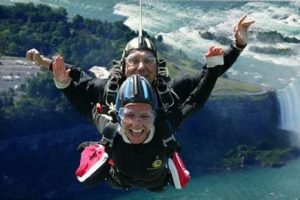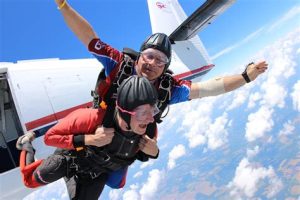Table of Contents
The weight limit for a tandem skydive varies depending on the drop zone and equipment used. Typically, the maximum weight limit ranges from 200 to 240 pounds (90 to 109 kilograms). It’s important to check with the specific skydiving center to ensure you meet the weight requirements for a safe and enjoyable tandem skydive experience.
Are you a thrill-seeker ready to experience the ultimate adrenaline rush? If so, tandem skydiving might be just the adventure you’ve been dreaming of! But before you take the plunge, it’s essential to know the weight limit for this exhilarating activity. Strap in and get ready for an informative journey as we delve into the world of tandem skydiving weight restrictions. So, whether you’re a seasoned daredevil or a first-time adventurer, let’s explore the guidelines that determine who can soar through the skies together.
Introduction
Tandem skydiving is an exhilarating adventure that allows individuals to experience the thrill of freefalling from an airplane while harnessed to a professional skydiver. It is a popular activity for both adrenaline junkies and those seeking a unique and memorable experience. However, one important consideration when planning a tandem skydive is the weight limit imposed by skydiving centers. In this article, we will discuss the weight limit for a tandem skydive and why it is essential for safety.
The Weight Limit
Every skydiving center has a weight limit for tandem skydiving, which is determined based on various factors such as equipment capabilities, safety regulations, and the instructor’s expertise. The weight limit typically ranges between 200-240 pounds (90-109 kg) but may vary depending on the specific drop zone. It is crucial to respect these weight restrictions to ensure a safe and enjoyable experience for everyone involved.
Reasons for Weight Limit
The weight limit for tandem skydiving exists for several reasons. Firstly, the equipment used in tandem jumps, including the parachute system, harnesses, and other components, are designed and tested to withstand certain weight limits. Exceeding these limits could compromise the integrity and safety of the equipment, potentially leading to accidents or injuries. Secondly, the instructors need to be able to maintain control during both the freefall and landing phases. Therefore, adhering to the weight limit ensures that the instructor can effectively manage the descent and maintain stability throughout the jump.
Equipment Considerations
The weight limit for tandem skydiving takes into account the capabilities of the equipment used in the activity. Parachute systems are designed to support a specific weight range, and exceeding these limits can put excessive strain on the gear, jeopardizing its functionality. By adhering to the weight limit, skydivers can have confidence in the reliability and performance of the equipment, enhancing their safety during the jump.
Freefall Stability
During a tandem skydive, the instructor is responsible for maintaining stability and control throughout the freefall phase. Exceeding the weight limit can make it challenging for the instructor to achieve and maintain the desired stability, potentially compromising the safety and experience of both individuals involved in the jump. Adhering to the weight limit ensures that the instructor can effectively manage the freefall, allowing for a more enjoyable and controlled experience.
Safe Landing
Landing is another critical aspect of tandem skydiving, and the weight limit plays a significant role in ensuring a safe touchdown. Instructors need to be able to control the descent speed and direction during the landing phase. By adhering to the weight limit, instructors can better anticipate and manage the landing, reducing the risk of injuries or accidents. Additionally, staying within the weight limit allows for a smoother and more controlled landing experience.
Exceptions and Additional Fees
Skydiving centers may have specific policies regarding weight limits, including exceptions or additional fees for individuals who exceed the standard weight restrictions. In some cases, individuals who are slightly above the weight limit may still be able to participate in tandem skydiving by paying an extra fee or meeting specific criteria set by the drop zone. It is essential to check with the skydiving center beforehand to understand their policies and make necessary arrangements if applicable.
Health Considerations
Besides weight, other health factors may also be taken into account when considering tandem skydiving. Individuals with certain medical conditions or physical limitations may require additional precautions or medical clearance to participate in the activity. It is crucial to inform the skydiving center about any relevant health concerns beforehand to ensure the safety of all participants involved.
Conclusion
Understanding and respecting the weight limit for a tandem skydive is vital for both the safety of the participants and the overall experience. By adhering to these limits, individuals can enjoy the thrill of skydiving while minimizing risks and ensuring the proper functioning of equipment. Remember to check with your local skydiving center for specific weight restrictions, exceptions, or additional requirements to have a safe and unforgettable tandem skydiving experience.
What Is the Weight Limit for a Tandem Skydive?
Introduction:
Welcome to our article on the weight limit for a tandem skydive. In this guide, we will provide you with important information and guidelines regarding the maximum weight allowed for tandem skydivers. Please read through the instructions carefully to ensure a safe and enjoyable skydiving experience.
1. Understanding the Weight Limit:
The weight limit for a tandem skydive refers to the maximum weight a participant can have to safely engage in this activity. This limit is crucial to maintain the balance and stability of the parachute system.
2. Importance of Weight Restrictions:
Maintaining weight restrictions is essential for the overall safety of both the tandem skydiver and the instructor. It allows for proper parachute deployment, ensures controlled descent rate, and guarantees a smooth landing.
3. Factors Influencing Weight Limits:
The weight limit for tandem skydiving is determined based on several factors, including the equipment capacity, instructor capabilities, and the specific drop zone’s regulations. These factors help ensure that the skydiving experience is enjoyable while minimizing any potential risks.
4. Average Weight Limit:
While weight limits can vary between different skydiving centers, the average weight limit for a tandem skydive usually falls within the range of 200 to 240 pounds (90 to 109 kilograms). This range may differ, so it is advisable to check with your specific skydiving center for their exact weight restrictions.
5. Height and Weight Proportions:
In addition to considering weight limits, it’s important to keep in mind that height can also play a role in determining whether you can safely participate in a tandem skydive. This is because the harness used for tandem skydiving needs to be securely and comfortably fitted on the participant.
6. Safety Precautions for Exceeding Weight Limits:
If you exceed the weight limit set by the skydiving center, they may still allow you to skydive but with certain safety precautions. These precautions may include requiring the use of specialized equipment, an additional instructor, or even rescheduling the jump for a later date.
7. Communicating Accurate Weight:
When booking a tandem skydive, it is crucial to provide your accurate weight. Misrepresenting your weight can compromise the safety of the skydiving activity for both you and your instructor, leading to potential risks during the jump.
8. Consultation and Individual Assessment:
If you’re unsure about whether you meet the weight requirements for a tandem skydive or if you have any other concerns, it is recommended to consult with the skydiving center directly. They can provide you with accurate information and, if necessary, conduct an individual assessment to ensure a safe and enjoyable skydiving experience.
Remember, tandem skydiving aims to provide an exhilarating adventure while prioritizing safety. Adhering to the weight limits set by your chosen skydiving center is essential for an unforgettable, worry-free skydiving experience.
When it comes to tandem skydiving, it is important to consider the weight limit for safety reasons. The weight limit ensures that the parachute system can safely support the weight of both the instructor and the passenger during the jump and landing. Here are some instructions and guidelines regarding the weight limit for a tandem skydive:
-
Know the specific weight limit: Each skydiving center or drop zone may have different weight limits due to variations in equipment and safety protocols. It is essential to check with the specific facility you plan to skydive with to determine their weight limit.
-
Understand the weight distribution: Tandem skydiving involves an instructor being harnessed to the passenger. The weight limit takes into account the combined weight of both individuals to ensure a safe and controlled descent.
-
Consider additional restrictions: Some skydiving centers may have additional restrictions based on body shape, height, or physical fitness. These restrictions are in place to ensure a comfortable and safe skydiving experience for both the instructor and the passenger.
-
Familiarize yourself with alternative options: If you exceed the weight limit for a tandem skydive, there may be alternative options available to accommodate your desire to skydive. These options could include specialized equipment, solo skydiving with proper training, or weight loss programs to reach the weight limit.
-
Consult with the skydiving center: If you are unsure about whether you meet the weight limit requirements, it is always best to consult with the skydiving center directly. They can provide you with accurate information and guidance regarding your specific situation.
Remember, the weight limit for a tandem skydive is in place to prioritize safety and ensure an enjoyable experience for everyone involved. By following the instructions and guidelines set by the skydiving center, you can have a thrilling and safe tandem skydiving adventure.
Thank you for visiting our blog and taking the time to read our article on the weight limit for a tandem skydive. We understand that this is a topic of interest for many people who are considering experiencing the exhilaration of skydiving. In this closing message, we would like to summarize the key points discussed in the article and provide some final thoughts on the matter.
First and foremost, it is essential to note that different skydiving centers may have varying weight limits for tandem skydives. This is primarily due to safety reasons, as the equipment used during tandem jumps is designed to accommodate specific weight ranges. Therefore, it is crucial to check with your local skydiving center or the center you plan to visit to determine their specific weight restrictions.
However, as a general guideline, most skydiving centers set a weight limit of around 225 pounds (102 kilograms) for tandem skydives. This weight limit ensures that the parachute system can safely support both the instructor and the student throughout the jump. Exceeding this weight limit may compromise the safety and performance of the equipment, which is why it is strictly enforced.
In addition to the weight limit, it’s important to consider other factors that may affect your ability to participate in a tandem skydive. These factors include height, age, and overall fitness level. Skydiving centers typically require participants to be at least 18 years old and in good health. Some centers may also have height restrictions due to the size limitations of the equipment used. It is always advisable to consult with the skydiving center beforehand to ensure that you meet all the necessary criteria.
In conclusion, while the weight limit for a tandem skydive may vary from one skydiving center to another, it is generally around 225 pounds (102 kilograms). This weight restriction exists to ensure the safety and optimal performance of the parachute system. Remember to check with your local skydiving center for their specific weight limit and any other requirements they may have. Skydiving is an incredible experience that should be enjoyed safely, so it’s important to adhere to these guidelines. We hope this article has provided you with valuable information, and we wish you the best in your future skydiving adventures!
Video What Is The Weight Limit For A Tandem Skydive
When it comes to tandem skydiving, it’s common for people to have questions about the weight limit. Here are some frequently asked questions and their corresponding answers:
-
What is the weight limit for a tandem skydive?
The weight limit for a tandem skydive can vary depending on the skydiving center and the equipment they use. However, in general, the weight limit is typically around 220-230 pounds (100-105 kilograms) for men and 200 pounds (90 kilograms) for women. It’s important to note that these limits are in place to ensure safety and proper functioning of the equipment during the jump.
-
Why is there a weight limit for tandem skydiving?
Tandem skydiving involves two individuals being connected by a harness and sharing a parachute. The weight limit is in place to ensure that the instructor and the equipment can safely handle the additional weight during freefall and landing. Exceeding the weight limit may compromise the safety and effectiveness of the parachute system, which is why it’s important to adhere to these limitations.
-
Can exceptions be made for individuals exceeding the weight limit?
In some cases, exceptions can be made for individuals who are slightly above the weight limit. However, this depends on various factors such as body proportions, fitness level, and the specific gear available at the skydiving center. It’s essential to contact the skydiving center in advance to discuss your individual circumstances and determine if any accommodations can be made.
-
Are there any additional costs for individuals exceeding the weight limit?
Some skydiving centers may charge additional fees for individuals who exceed the weight limit. This is because special equipment or modifications may be required to ensure a safe and comfortable skydive. It’s recommended to inquire about any potential surcharges when making your reservation or contacting the skydiving center.
-
What should I do if I exceed the weight limit for tandem skydiving?
If you exceed the weight limit for tandem skydiving, don’t be discouraged! Skydiving centers often offer alternative options such as accelerated freefall (AFF) training, which allows individuals to undergo solo skydiving training. This way, you can still experience the thrill of skydiving while adhering to safety guidelines.
Remember, the weight limit for a tandem skydive is in place to prioritize safety and ensure an enjoyable experience for everyone involved. If you have any further questions or concerns, feel free to reach out to the skydiving center directly for more information.






